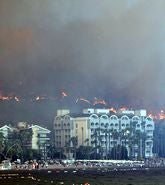Looking at the countless examples of flooding events during 2022, including in the United States, Australia, South Africa, and Pakistan, they all highlight the devastating effects that flooding poses to the affected communities.
Examining the floods in Pakistan from June through to October 2022, some 33 million citizens were impacted, over 1,700 people were killed, and over 2.2 million properties were destroyed or damaged.
A true global peril, floods can occur at any time, anywhere there is precipitation, and events can be frequent and certainly do not respect geographic borders or limit their effects to those located close to water bodies such as rivers.
The impact of climate change on flood events is complex – for instance, warmer temperatures mean that the atmosphere retains more moisture resulting in extreme precipitation events. At the same time, drier soils, shorter duration rainfall, and less snowmelt could minimize flood impacts.
Assessing flood risk is challenging and becoming more urgent than ever for groups such as asset owners and managers, and real estate investors. Flood risk requires the use of highly granular data to help understand peril risk at an individual asset level.
Integration of RMS Global Flood Maps
Moody’s RMS is the world’s leading provider of natural catastrophe models and has over 30 years of experience providing granular, asset-specific data to help inform the assessment and quantification of flood risk.
The Moody’s RMS Climate on Demand version 2 application, planned for release in January 2023, will now incorporate RMS Global Flood Maps (GFM) as part of a longer-term integration to support the quantification of climate impacts through the addition of impact and financial metrics.
The data used in the GFM is derived from RMS probabilistic risk models. These are event-based models and account for precipitation as well as topography-related factors that can influence whether rainfall will lead to flooding.
For instance, the RMS models consider how rain enters river networks (and any overtopping that might cause), as well as the more localized ’ponding‘ of flood risk that can occur in low-lying elevation areas – even those that are not located near surface waters.
One of the key benefits of using the RMS models is that they leverage insights from both a spectrum of observed historical events and a stochastic event set that reflects the full range of possible events in space and time, based on 50,000 years of simulation to capture extremes. From this, views of risk are generated to include hazard return period outputs that better capture flood risk.
For countries such as the U.S. where we have an established inland flood model, users can see how our GFM aligns with or supplements the FEMA view of flood risk. For further information on how Moody’s Climate on Demand’s global flood perspective using the RMS GFM integration compares to FEMA flood maps, read this blog.
Developing Consistent Global Flood Risk Data
For many countries, the data required to develop a functioning hydrological model is incomplete or insufficient. A core part of the development of the new RMS GFM was to work out how to overcome the shortcomings in data availability while enabling an assessment of flood risk that is globally consistent.
Launched in 2021, the RMS GFM incorporates a new, unique methodology that combines best-in-class science with advances in technology to develop flood extents and depths globally.
For a primer on global flood risk drivers, check out these RMS “Five Things You Didn’t Know About Flood Risk” blogs; Part One and Part Two.
RMS already has established inland flood models for countries such as the U.S., Europe, and Japan, and these models were used to train a machine learning model that can enable a representation of flood extents not only in these modeled countries but also in territories that lack the high-quality data that can be used to create a full hydrological model.
The result is a leveling-out of flood risk analysis, with representations of flood risk for developed countries using established models as well as in those countries, where the data needed to develop models is limited.
Unifying a level of flood risk analysis across all countries ultimately means that flood risk can be accessed at both the regional and global levels consistently across portfolios.
Accounting for Flood Mitigation
More recently, RMS has developed a global view of the Standard of Protection to assess infrastructure that helps mitigate flood risk. This view was developed to understand the implications of levees, banks, and other man-made structures that alter flood risk potential at a site.
This again helps to unify data quality across different regions and to account for the shortcomings in publicly available data for flood defenses which can be incomplete and outdated.
The result is access to high-quality, high-resolution views of flood risk globally that enable more informed flood risk assessment. The GFM data provides both the extent of inundation and the flood depth at 30-meter resolution, across multiple return periods (from 10 to 1,000 years), from high to low exceedance probabilities that consider the implications of defenses.
Incorporating Future Flood Risk
As Moody’s Climate on Demand integrates RMS flood modeling capabilities and data, it will provide users with a forward-looking, consistent and granular view of flood risk drivers.
The Climate on Demand approach will integrate RMS GFM together with peer-reviewed global climate model estimates that capture changes in worldwide precipitation, along with scenario analysis views available through 2100.
Assets showing the highest flood risk in Climate on Demand are highly susceptible to flooding and/or potentially exposed to changes in extreme precipitation that further exacerbate flood risk as the climate warms.
Users will be able to expose and unpack the primary drivers of an individual asset’s estimated flood risk, with Climate on Demand distilling these complex analytics into simple and easy-to-use metrics that enable effective forward-looking flood risk assessment.
Businesses are already benefiting from Moody’s Climate on Demand physical risk scoring application that provides a forward-looking view of an asset’s exposure to a range of physical climate risks including floods, heat stress, hurricanes and typhoons, sea level rise, water stress, and wildfires.
Today, Moody’s Climate on Demand application can evaluate the forward-looking climate hazard exposure of a portfolio of assets anywhere in the world in real-time, allowing users to examine specific risk drivers and explore underlying indicators that capture various dimensions of hazard risk.
Find out more about Climate on Demand or email us by clicking here.






